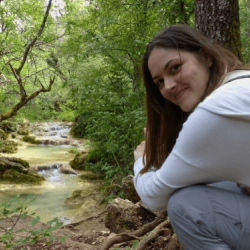
Lise ROPARS



61 rue Buffon
75005 Paris
Membre du programme de Mentorat de Sorbonne Université
Mes travaux de recherche se concentrent sur plusieurs domaines clés de l’écologie : l’Écologie des communautés, l’Écologie de la pollinisation, l’Écologie du paysage, l’Écologie urbaine et la Biologie de la conservation. Mon objectif principal est d’explorer les effets des pressions anthropiques sur les pollinisateurs et les plantes, ainsi que sur les réseaux d’interactions complexes qui les lient.
Actuellement, je coordonne le projet de Liste Rouge des abeilles sauvages, une initiative visant à établir un statut de conservation UICN pour toutes les espèces d’abeilles sauvages présentes en France métropolitaine. Ce projet est crucial pour la préservation de la biodiversité et pour mieux comprendre les défis auxquels sont confrontées ces espèces.
Avec une approche appliquée, je m’efforce de rendre mes recherches accessibles et utiles à tous. Je partage ainsi mes connaissances et résultats avec les scolaires, les étudiants, les gestionnaires de territoires, et plus largement avec l’ensemble de la société, pour sensibiliser et encourager une meilleure coexistence entre l’humain et son environnement.
My work spans several key areas of ecology: Community Ecology, Pollination Ecology, Landscape Ecology, Urban Ecology and Conservation Biology. I aim to investigate the impacts of human activities on pollinators, plants, and the intricate interaction networks that connect them.
I currently lead the French Wild Bees Red List project, an initiative dedicated to establishing IUCN conservation statuses for all wild bee species in mainland France. This project is vital for safeguarding biodiversity and addressing the growing challenges these species face.
With a strong emphasis on applied research, I am committed to making my findings accessible and impactful. I regularly engage with school groups, students, land managers, and the broader public to share insights and raise awareness. By doing so, I hope to inspire a greater understanding of and responsibility for our environment, fostering a more harmonious relationship between humans and nature.
Requier, F., Abdelli, M., Baude, M., Genoud, D., Gens, H., Geslin, B., … & Ropars, L. (2024). Neglecting non-bee pollinators may lead to substantial underestimation of competition risk among pollinators. Current Research in Insect Science, 100093.
Fauviau, A., Fiordaliso, W., Fisogni, A., Fortel, L., Francis, F., Geslin, B., …, Ropars, L., … & Henry, M. (2024). Larger cities host richer bee faunas, but are no refuge for species with concerning conservation status: empirical evidence from Western Europe. Basic and Applied Ecology, 79, 131-140.
Badiane, A., Ropars, L., Flacher, F., Schurr, L., Zakardjian, M., Affre, L., … & Geslin, B. (2024). Urbanisation impacts the diversity, coloration, and body size of wild bees in a Mediterranean city. Regional Environmental Change, 24(2), 41.
Geslin, B., Mouillard-Lample, L., Zakardjian, M., Dajoz, I., Flacher, F., Henry, M., …, Ropars, L., … & Gauzens, B. (2023). New insights on massively introduced managed species and their consequences for plant–pollinator interactions. In Advances in Ecological Research (Vol. 68, pp. 63-89). Academic Press.
Reverté, S., Miličić, M., Ačanski, J., Andrić, A., Aracil, A., Aubert, M., …, Ropars, L., … & Vujić, A. (2023). National records of 3000 European bee and hoverfly species: A contribution to pollinator conservation. Insect conservation and diversity, 16(6), 758-775.
Fauviau, A., Baude, M., Bazin, N., Fiordaliso, W., Fisogni, A., Fortel, L., …, Ropars, L., … & Henry, M. (2022). A large-scale dataset reveals taxonomic and functional specificities of wild bee communities in urban habitats of Western Europe. Scientific Reports, 12(1), 18866.
Lair, X., Ropars, L., Skevington, J. H., Kelso, S., Geslin, B., Minssieux, E., & Nve, G. (2022). Revision of the genus Pelecocera Meigen, 1822 (Diptera: Syrphidae) from France: taxonomy, ecology and distribution. Zootaxa, 5141(1), 1-24.
Ropars, L., Affre, L., Thébault, É., & Geslin, B. (2022). Seasonal dynamics of competition between honey bees and wild bees in a protected Mediterranean scrubland. Oikos, 2022(4), e08915.
Ropars, L., Affre, L., & Geslin, B. (2021). Morphometric identification of honey bee subspecies reveals a high proportion of hybrids within a Mediterranean protected area. Journal of Apicultural Research, 60(5), 871-874.
Ropars, L., Affre, L., Aubert, M., Fernandez, C., Flacher, F., Genoud, D., … & Geslin, B. (2020). Pollinator specific richness and their interactions with local plant species: 10 years of sampling in Mediterranean habitats. Environmental Entomology, 49(4), 947-955.
Ropars, L., Affre, L., Schurr, L., Flacher, F., Genoud, D., Mutillod, C., & Geslin, B. (2020). Land cover composition, local plant community composition and honeybee colony density affect wild bee species assemblages in a Mediterranean biodiversity hot-spot. Acta Oecologica, 104, 103546.
Geslin, B., Gachet, S., Deschamps-Cottin, M., Flacher, F., Ignace, B., Knoploch, C., …, Ropars, L., … & Le Féon, V. (2020). Bee hotels host a high abundance of exotic bees in an urban context. Acta Oecologica, 105, 103556.
Ropars, L., Dajoz, I., Fontaine, C., Muratet, A., & Geslin, B. (2019). Wild pollinator activity negatively related to honey bee colony densities in urban context. PloS one, 14(9), e0222316.
Geslin, B., Gauzens, B., Baude, M., Dajoz, I., Fontaine, C., Henry, M., …, Ropars, L., … & Vereecken, N. J. (2017). Massively introduced managed species and their consequences for plant–pollinator interactions. In Advances in ecological research (Vol. 57, pp. 147-199). Academic Press.
Les abeilles sauvages sont en déclin à l’échelle de l’Europe. Elles ont pourtant un rôle majeur dans le service de pollinisation aussi bien dans les écosystèmes naturels que les agro-écosystèmes. Il apparait donc essentiel d’évaluer l’état de conservation des populations d’abeilles sauvages. Ce projet consiste à élaborer une Liste rouge des abeilles sauvages en France métropolitaine et à proposer des actions de restauration de leurs habitats principalement dans l’espace rural.